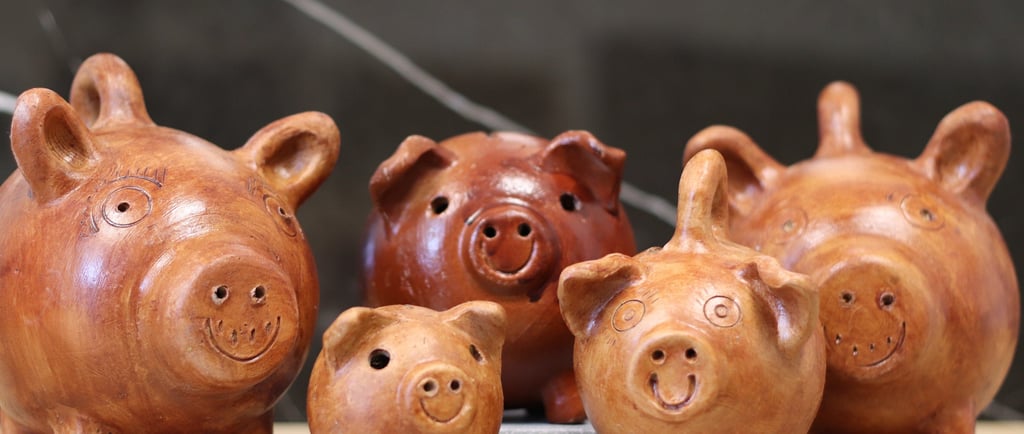🐷 The Little Pig from Pomaire 🇨🇱
🐷 A follow-up story that branches from the Fundamental Needs and History Question Charts in the History Album, while also connecting to Human Geography in the Geography Album. ✨ The Little Pig from Pomaire invites children to explore how humans across time have shaped, stored, and honored their traditions.🏺 🇨🇱🔥 This story reveals how the land itself—rich in black-reddish clay—shaped tradition and craft, reminding us that the environment deeply influences how people meet their needs. 🌍🧱 From Greek temple-shaped money boxes to elephant banks in India, children explore evolving forms of value across cultures, revealing an invisible thread: the creative ways humans meet both economic and spiritual needs. 💡🌿 It sparks wonder: “How did other civilizations and cultures store their values?” 🧠✨ And another question begins to form… 🗣️ “What other words in English have changed their meaning over time?”
HISTORY STORIES
10/17/20253 min read


Stretching like a long ribbon of land between the Pacific Ocean and the Andes Mountains, there lies a country called Chile. 🇨🇱It is one of the longest countries on Earth — with icy glaciers in the south, dry deserts in the north, and mountains that run the whole length like a jagged spine. 🏔️🌊
👉Let's find this long country on the map!
About halfway down this ribbon of land, tucked between green hills and quiet valleys, there is a region where the land gives something special — a soft, black-reddish clay, perfect for shaping. 🧱
For generations, the people of Pomaire have used this gift from the earth to make useful things: pots to cook in, jugs to carry water, and jars to store grains, oil, seeds… Today, pottery in this part of Chile is not just a job — it’s part of a very old tradition passed from hand to hand. 👐🔥
In Old English, people called this orange-red clay “pygg” (🟠 pronounced like “pig”). The jars people in Pomaire used it to make with this reddish brown clay were called “pygg jars.” As people started to trade and metal coins were invented, they needed a place to store their money — so they dropped their coins into these pygg jars. And over time, when saving coins became more common, the jars were called “pygg banks.”🏺
Eventually, as the English language evolved, “pygg” and “pig” came to sound the same, and people slowly forgot that pygg once referred to clay jars and cups. 🏺 People, being creative, had a clever idea: why not make pygg bank shaped like a pig? 🐷 And just like that, the pig became the guardian of coins. 💰
Today in Pomaire, the little pigs made from clay are called chanchitos, which means “little pig” in Spanish. 🇨🇱 They are still shaped by hand, baked in fire, and polished until they shine. Potters give them smiles and round bellies, and sometimes they make them with three legs instead of four — because people say that brings good luck. 🍀
In many cultures, the pig became a symbol of abundance and good fortune. Pigs grow big and round. They don’t waste anything — they eat everything, store energy, and give back. In many countries people still exchange small pig figurines at Christmas or New Year’s. They’re made of marzipan, wood, or glass — and each one carries a wish: "May your year be full.” ✨
From the day people began to trade with money, they had a need to store it — to keep it safe, hidden, or just in one place until it was needed.But not everyone used pigs!
Even before the pygg pots, more than 2,200 years ago, the Ancient Greeks saved their coins in clay moneyboxes shaped like buildings— tiny temples with pillars and roofs. 🏛️ For them, temples were places of honor, protection, and offering. Saving money in a temple shape reminded people that wealth was not just to be spent, but respected. While in Indonesia, people shaped clay banks like roosters — symbols of watchfulness, luck, and the sunrise of a new day. 🐓All around the world, people crafted different vessels in which they stored their most valuable items. And then, in a small town in Chile, something round and smiling appeared — the little clay pig from Pomaire. 🐷 Known all over the world as "Piggy Bank."
💭 I wonder.... What about other cultures around the world? How did they store their money or other valuable items?
I brought some clay, to make your own money bank. Or you could even try shaping your own chanchito out of clay — and give it as a gift for good luck. 🐖
🧩 Possible Follow-Up Explorations
🗺️ Create a map showing different saving traditions around the world
📚 Research how the invention of money changed how people stored and traded
🐖 Design your own symbol for good fortune and explain its meaning
🔍 Some words we use every day didn’t always mean what they mean now. Can you find a word that changed its meaning over time? Or a word that disappeared and got replaced by something new?
Awful → used to mean “full of awe” (inspiring) → now means “very bad.”Nice → once meant foolish or silly → now means kind or pleasant.
Meat → used to mean any kind of food → now means animal flesh only
With Montessori joy,
Vanina 😊

